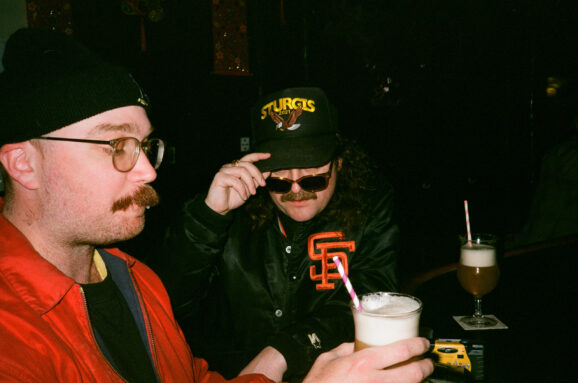Neil Young and the Chrome Hearts’ Talkin’ To The Trees is nowhere near as confounding as the Canadian’s latest efforts with Crazy Horse. It’s far more compelling than 2019’s Colorado and Barn from two years later and even World Record from 2022, in part because its comparably impromptu atmosphere enhances rather than detracts from the credibility of the material and the performances.
Consider the prominent use of acoustic guitar, pedal steel, and harmonica, which is evident from the very first cut, “Family Life.” In its folksy way, it’s a real-time exercise in self-reference during which Young sounds only a little disingenuous (mentioning ‘my best wife ever’). The boozy shuffle that is “Dark Mirage” is a more honest expression of inter-personal conflict, the fractures of which are reflected in the cracks in Neil’s voice as he sings.
But as the other members of The Chrome Hearts chime in with vocals on the refrain, it becomes decidedly more celebratory, a marked contrast to the bittersweet tone of “First Fire Of Winter.” At this point, it’s tempting to categorize this fortieth or so album of the former Buffalo Springfielder as one of the most carefully crafted of his catalog.
Lou Adler, a one-time studio supervisor for The Mamas & the Papas and Carole King, shares credit for such sage production. Yet it’s important to note the recordings were engineered and mixed by Young’s long-time technical aide, John Hanlon, at Rick Rubin’s Shangri-La Studios in Malibu. As a result, there is a remarkable clarity that arises from tracks such as “Silver Eagle.”
But figuring into an almost equal extent is the no-frills musicianship of this new lineup of accompanists, all of whom have a history with Neil. Bassist/vocalist Corey McCormick and drummer Anthony Logerfo are refugees from the band Promise of the Real (who backed Young for several years with titular leader Lukas Nelson).
The rhythm section is crucial in keeping the performances focused, but no more so than that of guitarist/vocalist Micah Nelson — late of POTR, too, and also of the latest Crazy Horse lineup — as well as organist Spooner Oldham (of Muscle Shoals’ FAME Studios and Young’s own Harvest Moon). All four display an admirable humility in remaining unobtrusive when the arrangement calls for it, as on “Let’s Roll Again.”
Likewise, Neil thankfully renders the topical allusions of the latter with a tongue-in-cheek attitude. Such lightheartness is a welcome respite from the pedantry of which he’s often been guilty since 2015’s The Monsanto Years. Still, it fortifies the point(s) Young’s making about industry and commerce, as well as global economics.
January 2025 saw the digital-only release of “Big Change” as a single, but this heavy riff number fits in well here, too. Sequenced at the very threshold of this album’s home stretch, its full and deep resonance, along with the deliberate lack of invention in its chord progression, illustrates this long player’s cogent perspective. Neil and company hammer away with a purpose.
With just a little more hindsight, the title song achieves the same end. Knowingly (?) evoking his vintage solo acoustic style of the Seventies, Neil dispels any notion this inveterate iconoclast harbors any illusions about his impact on the world at large. Instead, references to conversations with Bob Dylan give way to whimsical notions far removed from any pretensions to profundity.
The lurching gait of Young and the Hearts on “Movin’ Ahead” is entirely in line with the ornery mindset exhibited in its lyrics. But ultimately, there’s an optimistic tone to the tune, emanating as much from the sound of the tack piano and broad swathes of organ as from its title. More varied instrumental textures immediately follow with the glowing acoustic piano and vibes throughout “Bottle of Love.”
Even as an oblique contemplation of mortality, the closing that is the precious “Thankful” comes dangerously close to saccharine due to the sweet vocal harmonies. However, in that regard, it’s quite reminiscent of 1978’s Comes A Time, the ever-so-dulcet tone of which disguised a tumultuous period in Neil Young’s life and career, similar to recent months (cancelling tour dates with The Horse in summer 2024 led to the assembly of this new group).
At least on its surface, Talkin’ To The Trees radiates a self-effacing honesty. As such it is sufficiently thought-provoking to compel at least one theory that the source of Neil Young’s inspiration here is based on the presence of The Chrome Hearts: no doubt there’s a good reason he nabbed the name of the ensemble from a line in “Long May You Run.”










One Response
This is possibly the worst album in Neil’s career. The lyrics are awful half-assed efforts that a 15 year old kid with a second grade vocabulary could rewrite with better results. The music is tired and clunky. Spooner Oldham is not featured enough and The Promise of The Real rhythm section aren’t up to the job here. Neil clearly needs another Daniel Lanois to produce an album and maybe it’s time to collaborate on songwriting too. This makes Peace Trail sound like Rust Never Sleeps. Songwriting block, indeed, Neil. You are still the best songwriter and musician in my mind, but the last 6 years have been hard outside of Before and After and Barn.